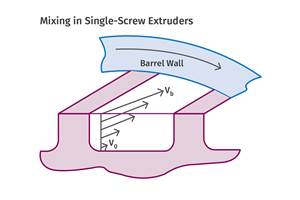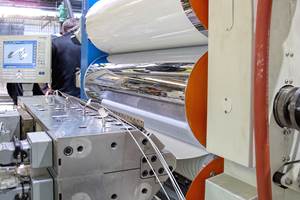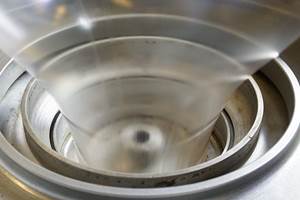What’s the Deal With High-Speed Extruders?
Extrusion Know How
If we are talking about extruder screw speed, how about 1800 rpm? That’s how fast some extruders are running today.
How fast is fast? If we are talking about extruder screw speed, how about 1800 rpm? That’s how fast some extruders are running today. With all we have heard about the advantages of running slowly for better control, does such blazing speed make sense?
There is certainly something to it, but results have been kept as guarded secrets by most processors using these machines. But high-speed extruders are not new. The first one I saw was in the 1980s, developed by George Kruder of HPM Corp., an industry pioneer. He built an extruder that ran at about 800 rpm using his “wave” screw design. It ran well, but its use was limited pretty much to color compounding.
Most of today’s high-speed extruders tend to have direct drive with no gearbox, and they are typically 40-50:1 L/D to provide sufficient melting area for the additional output. Outputs are truly remarkable and are almost directly proportional to the speed. For example, a 2.5-in. machine could put out 3000 lb/hr for HIPS or 2000 lb/hr for PP.
The actual performance of modern high-speed extruders goes against some of the long-held concepts of extrusion. For example, the linearity of output with screw speed is surprising. The screw is turning so fast it might be expected to block the flow of polymer into the feed flights, but that’s not the case. Because of the rate of solids feeding, trapped air can be an issue that must be dealt with by venting. Ability to vent might be expected to be compromised because of the short time that melt is exposed to the vent, but again that does not seem to be the case.
Extruders typically show greater and greater barrel temperature override as the screw speed is increased, but the special screw designs developed for these machines have made it possible for the heat to be absorbed into the polymer with little or no barrel override at very high speeds. It seems likely that the size of high-speed extruders could be limited because heat-transfer issues increase as the screw size increases. I have not heard of any larger than 90 mm being successful at those high speeds.
Polymers that exhibit greater non-Newtonian behavior (more shear thinning) have been the most successful to date. Polymers having more Newtonian behavior are much more difficult to maintain at realistic melt temperatures, and their use on high speed extruders is still in the R&D stage.
There are obvious advantages and some potential disadvantages to the high-speed extruders. The oldest of these machines have been in full service for just three to five years and again, the results have been kept pretty much under wraps. So the disadvantages have not been quantified.
Some of the advantages are:
•Reduced capital investment based on output.
•Reduced floor-space requirement.
•Improved electrical efficiency due to no gearbox losses and less surface area for heat dissipation.
•Generally improved polymer properties due to shorter residence time at elevated temperature.
•Reduced purging and changeover time due to lower volume in the screw.
Some of the potential disadvantages that I can envision are:
•Rapid screw/barrel wear.
•More complicated, precise, and polymer-specific screw designs.
•Reduced thrust-bearing life and increased thrust-bearing cost because of the higher speed.
•Need for specially designed motors (or use of 1:1 reducers with conventional motors).
Floor space is seldom a reason to consider high-speed extruders, as they are nearly as long as a larger extruder of equal output, though they are narrower. Capital cost savings have not been much of a factor to date; these machines require special motors, much larger thrust bearings, and special screws. Their value is in better mixing, greater energy efficiency, and lower polymer residence time. In short, high-speed extruders have proven benefits but they bring a number of potential problems with them. As R&D work continues, many of these issues will be eliminated or at least minimized in the future.
Related Content
Single vs. Twin-Screw Extruders: Why Mixing is Different
There have been many attempts to provide twin-screw-like mixing in singles, but except at very limited outputs none have been adequate. The odds of future success are long due to the inherent differences in the equipment types.
Read MoreShredding Thin Film: How to Do It Right
While many processors recoil at this task, a little know-how in shredding equipment, processing, and maintenance should add the necessary confidence.
Read MoreRoll Cooling: Understand the Three Heat-Transfer Processes
Designing cooling rolls is complex, tedious and requires a lot of inputs. Getting it wrong may have a dramatic impact on productivity.
Read MoreReduce Downtime and Scrap in the Blown Film Industry
The blown film sector now benefits from a tailored solution developed by Chem-Trend to preserve integrity of the bubble.
Read MoreRead Next
For PLASTICS' CEO Seaholm, NPE to Shine Light on Sustainability Successes
With advocacy, communication and sustainability as three main pillars, Seaholm leads a trade association to NPE that ‘is more active today than we have ever been.’
Read MoreBeyond Prototypes: 8 Ways the Plastics Industry Is Using 3D Printing
Plastics processors are finding applications for 3D printing around the plant and across the supply chain. Here are 8 examples to look for at NPE2024.
Read MorePeople 4.0 – How to Get Buy-In from Your Staff for Industry 4.0 Systems
Implementing a production monitoring system as the foundation of a ‘smart factory’ is about integrating people with new technology as much as it is about integrating machines and computers. Here are tips from a company that has gone through the process.
Read More.jpg;width=70;height=70;mode=crop)













